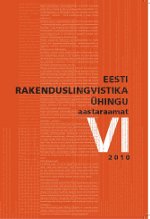Direktiivsed aktipaarid eestikeelsetes infodialoogides ja nende automaatne tuvastamine
Directive act pairs in Estonian information dialogues and their automatic recognition
Author(s): Mare Koit, Riina Kasterpalu, Andriela Rääbis, Olga Gerassimenko, Krista StrandsonSubject(s): Language and Literature Studies
Published by: Eesti Rakenduslingvistika Ühing (ERÜ)
Keywords: human–computer interaction; dialogue act; request; grant; Estonian
Summary/Abstract: This article studies Estonian human–human phone calls with the further aim of developing a human–computer dialogue system that interacts with the users in the natural language. The analysis is based on the Estonian Dialogue Corpus. Four situation types are considered: directory inquiries, calls to travel agencies, outpatients’ offices and taxi services. The most frequent directive act pairs in the dialogues are request — giving information and proposal — agreement. A client’s initial request sets up a goal (to get some information or to trigger the agent’s action, e.g. sending a taxi to the desired destination) which will be achieved in collaboration with the agent. The study analyzes the linguistic features of the clients’ directives and agents’ grants. In the dialogues, the officials give the information briefly by using short sentences and phrases. The information-sharing sub-dialogues are initiated by both participants depending on whether a request or a grant needs to be adjusted. The experiments on automatic recognition of dialogue acts in the Estonian Dialogue Corpus are described. Two different probabilistic suffix tree models have been implemented by Taavet Kikas. The first one uses the substrings of the utterances in order to classify the utterances into several dialogue acts. The second model uses the substrings together with the discourse information in the form of preceding and following dialogue act. In the experiments for directive adjacency pairs, the recall of 20%–71% and the precision 36%–56% have been achieved. The most frequent acts in the used training corpus – request and giving information – were recognized with the best recall. In conclusion, the probabilistic suffix trees turn out to be a promising data structure for dialogue act recognition.
Journal: Eesti Rakenduslingvistika Ühingu aastaraamat
- Issue Year: 2010
- Issue No: 6
- Page Range: 067-086
- Page Count: 19
- Language: Estonian

